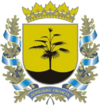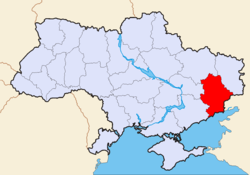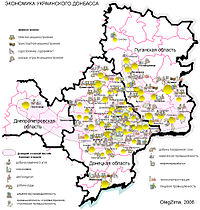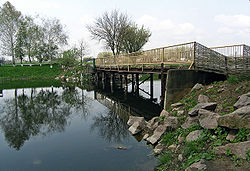- Donetsk Oblast
-
Donetsk Oblast
Донецька область
Donets’ka oblast’— Oblast — 
Flag
Coat of armsNickname(s): Донеччина (Donechchyna) Location of Donetsk Oblast (red) within Ukraine (blue) Country  Ukraine
UkraineEstablished June 3, 1938 Admin. center Donetsk Government – Governor Andriy Schyschatskyi (PR) – Oblast council 150 seats Area – Total 26,517 km2 (10,238.3 sq mi) Area rank Ranked 11th Population (2006) – Total 4,622,900 – Rank Ranked 1st – Density 174.3/km2 (451.5/sq mi) Demographics – Official language(s) Ukrainian – Average salary UAH 1161 (2006) Time zone EET (UTC+2) – Summer (DST) EEST (UTC+3) Postal code 83000-87999 Area code +380-62 ISO 3166 code UA-14 Raions 18 Cities of oblast subordinance 28 Cities (total) 52 Towns 131 Villages 1124 FIPS 10-4 UP05 Website www.donoda.gov.ua
www.rada.gov.uaDonetsk Oblast (Ukrainian: Донецька область, Donets’ka oblast’; also referred to as Donechchyna — Ukrainian: Донеччина Donechchyna; Russian: Донецкая область, Donetskaya oblast) is an oblast (province) of eastern Ukraine. Its administrative center is Donetsk. Historically, the province is an important part of the Donbas region. Until November, 1961, it bore the name Stalino Oblast in honour of Joseph Stalin.
Important cities within the oblast include: Sloviansk, Horlivka, Kramatorsk, Makiivka, Mariupol, Yenakiieve.
Contents
Geography
Donetsk Oblast is located in southeastern Ukraine. The area of the oblast (26,900 km²), comprises about 4.4% of the total area of the country. The oblast borders the Dnipropetrovsk and Zaporizhia Oblasts on the southwest, the Luhansk Oblast on the northeast, the Rostov Oblast in Russia on the east, and with the Sea of Azov on the south.
Its longitude from north to south is 270 km, from east to west – 190 km. The extreme points of the oblast's borders are: Bilosarayska Kosa (spit) on the south, Shevchenko of Velykonovosilkivskyi Raion on the west, Verkhnyi Kut of Shakhtarskyi Raion on the east, and Lozove of Krasnolymanskyi Raion on the north.
The state historic-architectural preserve near the city of Sviatohirsk with the Sviatohirsk Lavra was nominated for the Seven Wonders of Ukraine.
Administrative divisions
The oblast is subdivided into 18 raions (administrative districts). It consists of 28 municipalities, 52 cities, 131 towns, and more than 1,124 villages.
The following data incorporates the number of each type of administrative divisions of Donetsk Oblast:
- Administrative Center – 1 (Donetsk)
- Raions — 18;
- City raions — 28;
- Settlements — 1,283, including:
- Villages — 1,124;
- Cities/Towns — 159, including:
- Urban-type settlement — 131;
- Cities — 52, including:
- Cities of oblast' subordinance — 28;
- Cities of raion subordinance — 24;
- Selsovets — N/A.
The local administration of the oblast' is controlled by the Donetsk Oblast Rada. The governor of the oblast' is the Head of Donetsk Oblast administration, appointed by the President of Ukraine.
Raions
- Amvrosiivskyi
- Artemivskyi
- Dobropilskyi
- Kostyantynivskyi
- Krasnoarmiiskyi
- Krasnolymanskyi
- Marynskyi
- Novoazovskyi
- Oleksandrivskyi
- Pershotravnevyi
- Shakhtarskyi
- Slovyanskyi
- Starobeshivskyi
- Telmanivskyi
- Velikonovosilkivskyi
- Volnovaskyi
- Volodarskyi
- Yasynuvatskyi
Demographics
The population of Donetsk Oblast is 4.7 million (as of 2004[update]), which constitutes 10% of the overall Ukrainian population, making it the most populous and most densely populated region of the country. Its large population is due to the presence of several big industrial cities and numerous villages agglomerated around them (see urbanization).
During the 2004 presidential election, political supporters of Viktor Yanukovych threatened to demand autonomy for Donetsk and neighbouring oblasts if the election of their candidate was not recognised. However, no official moves were ever made.
As of the Ukrainian National Census, 2001, the ethnic groups within the Donetsk Oblast are: Ukrainians — 2,744,100 (56.9%), Russians — 1,844,400 (38.2%), Greeks – 77,500 (1.61%), Belarusians — 44,500 (0.92%), Crimean Tatars — 19,200 (0.4%), Armenians — 15,700 (0.33%), and Jews – 8,800 (0.18%).[1]
As of 2001[update], the languages spoken within the oblast' are: Russian — 74.9%, Ukrainian — 24.1%, and Armenian — 0.13%.[1]
Economy
Industry
The Donetsk Oblast covers more than one half coal, finished steel, coke, cast iron and steel production in Ukraine. Ferrous metallurgy, fuel industry and power industry are in demand in the structure of industry production. There are about 882 industry enterprises that are on independent balance, and 2,095 small industry enterprises in the oblast.[2]
The oblast' has a developed transport infrastructure which includes the Donetsk railway (covers 40% of national transportation), the Mariupol Port, the Donetsk International Airport, passenger airports in Mariupol and Kramatorsk, and dense road systems. In the Donetsk Oblast two special economic zones have been created, Donetsk and Azov, which have a privileged tax regime.[2]
Agriculture
In 1999, the gross grain yield in the oblast was about 999.1 thousand tons, sugar beets – 27.1 thousand tons, sunflower seeds – 309.4 thousand tons, and potatoes – 380.2 thousand tons.[2] Also, 134.2 thousand tons of meat, 494.3 thousand tons of milk and 646.4 million eggs have been produced. At the beginning of 1999 there have been 2108 farms within the oblast.[2]
Ecology
The Donetsk Oblast's climate is mostly continental, which is characterised by hot summers and relatively cold winters with changeable snow surfaces. East and southeast strong winds, high temperatures and heavy rain showers are typical in the summer. The average annual rainfall is 524 mm.
The basic minerals found here are: coal (reserves – 25 billion tons), rock salt, lime carbonate, potassium, mercury, asbestos, and graphite. The area is also rich in fertile black earth.
Important resources for recreation within the area are: the mild climate, the Sea of Azov coast, curative mud, sources of minerals, and radon and table water. Due to these numerous recreation resources, many resort hotels and camps are located here. There are about 26 health centres and pensions, 52 rest homes and boarding houses, and rest camps for children in the oblast.[2]
The curative areas in the oblast include the Slovyansk salt lakes and mineral water sources. The oblast also contains many park zones, some of which are of great national value. They include the Khomutivsky steppe and the Azov sea coast. Overall, the Donetsk Oblast contains about 70 objects of nature and park fund including branches of the Ukrainian steppe park, 6 state reserves, 10 memorials of nature, landscapes, and 6 park tracts.[2]
See also
- Subdivisions of Ukraine
- Donets Basin
References
- ^ a b Ukrcensus.gov.ua — Donetsk region URL accessed on January 13, 2007
- ^ a b c d e f Cabinet of Ministers of Ukraine — Donetsk Region URL accessed on January 13, 2007
- Information Card of the Region — Official site of the Cabinet of Ministers of Ukraine
External links
- www.citylife.donetsk.ua — Official Donetsk city guide – English (English)
- donoda.gov.ua — Official site of Donetsk Oblast Administration (English)(Ukrainian)(Russian)
- catalogue.biz.ua — Post codes directory of Donetsk Oblast (English)(Ukrainian)(Russian)
 Wikimedia Commons — Media on Donetsk Oblast
Wikimedia Commons — Media on Donetsk Oblast
 Administrative divisions of Ukraine
Administrative divisions of UkraineOblasts Cherkasy · Chernihiv · Chernivtsi · Dnipropetrovsk · Donetsk · Ivano-Frankivsk · Kharkiv · Kherson · Khmelnytskyi · Kiev · Kirovohrad · Luhansk · Lviv · Mykolaiv · Odessa · Poltava · Rivne · Sumy · Ternopil · Vinnytsia · Volyn · Zakarpattia · Zaporizhia · ZhytomyrCities with special status Autonomous Republic Administrative centers Cherkasy · Chernihiv · Chernivtsi · Dnipropetrovsk · Donetsk · Ivano-Frankivsk · Kharkiv · Kherson · Khmelnytskyi · Kiev · Kirovohrad · Luhansk · Lutsk · Lviv · Mykolaiv · Odessa · Poltava · Rivne · Sevastopol · Simferopol · Sumy · Ternopil · Uzhhorod · Vinnytsia · Zaporizhia · ZhytomyrCategories:- Donetsk Oblast
- Oblasts of Ukraine
- States and territories established in 1938
Wikimedia Foundation. 2010.





